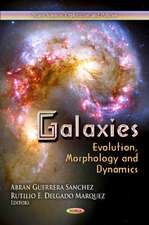Polycyclic Aromatic Hydrocarbons and Astrophysics: Nato Science Series C:, cartea 191
Editat de A. Léger, L. D'Hendecourt, N. Boccaraen Limba Engleză Hardback – 30 noi 1986
| Toate formatele și edițiile | Preț | Express |
|---|---|---|
| Paperback (1) | 1222.80 lei 43-57 zile | |
| SPRINGER NETHERLANDS – 26 sep 2011 | 1222.80 lei 43-57 zile | |
| Hardback (1) | 1057.17 lei 38-44 zile | |
| SPRINGER NETHERLANDS – 30 noi 1986 | 1057.17 lei 38-44 zile |
Din seria Nato Science Series C:
- 24%
 Preț: 797.69 lei
Preț: 797.69 lei - 18%
 Preț: 957.62 lei
Preț: 957.62 lei - 18%
 Preț: 957.13 lei
Preț: 957.13 lei - 18%
 Preț: 1227.52 lei
Preț: 1227.52 lei -
 Preț: 396.40 lei
Preț: 396.40 lei -
 Preț: 403.75 lei
Preț: 403.75 lei - 18%
 Preț: 1239.37 lei
Preț: 1239.37 lei - 18%
 Preț: 1236.51 lei
Preț: 1236.51 lei - 18%
 Preț: 1231.78 lei
Preț: 1231.78 lei - 18%
 Preț: 1229.10 lei
Preț: 1229.10 lei - 18%
 Preț: 1835.21 lei
Preț: 1835.21 lei - 24%
 Preț: 1076.39 lei
Preț: 1076.39 lei -
 Preț: 390.46 lei
Preț: 390.46 lei -
 Preț: 369.63 lei
Preț: 369.63 lei - 18%
 Preț: 1232.41 lei
Preț: 1232.41 lei -
 Preț: 394.51 lei
Preț: 394.51 lei - 18%
 Preț: 1226.24 lei
Preț: 1226.24 lei - 18%
 Preț: 1845.80 lei
Preț: 1845.80 lei -
 Preț: 399.88 lei
Preț: 399.88 lei -
 Preț: 384.28 lei
Preț: 384.28 lei -
 Preț: 390.88 lei
Preț: 390.88 lei -
 Preț: 381.19 lei
Preț: 381.19 lei - 18%
 Preț: 1848.64 lei
Preț: 1848.64 lei - 18%
 Preț: 951.14 lei
Preț: 951.14 lei - 18%
 Preț: 1230.35 lei
Preț: 1230.35 lei - 18%
 Preț: 1236.51 lei
Preț: 1236.51 lei -
 Preț: 401.03 lei
Preț: 401.03 lei -
 Preț: 406.25 lei
Preț: 406.25 lei - 18%
 Preț: 1230.84 lei
Preț: 1230.84 lei -
 Preț: 418.34 lei
Preț: 418.34 lei - 18%
 Preț: 1223.74 lei
Preț: 1223.74 lei
Preț: 1057.17 lei
Preț vechi: 1391.02 lei
-24% Nou
Puncte Express: 1586
Preț estimativ în valută:
202.35€ • 219.87$ • 170.09£
202.35€ • 219.87$ • 170.09£
Carte tipărită la comandă
Livrare economică 16-22 aprilie
Preluare comenzi: 021 569.72.76
Specificații
ISBN-13: 9789027723611
ISBN-10: 9027723613
Pagini: 422
Ilustrații: XV, 402 p.
Dimensiuni: 155 x 235 x 28 mm
Greutate: 0.77 kg
Ediția:1987
Editura: SPRINGER NETHERLANDS
Colecția Springer
Seria Nato Science Series C:
Locul publicării:Dordrecht, Netherlands
ISBN-10: 9027723613
Pagini: 422
Ilustrații: XV, 402 p.
Dimensiuni: 155 x 235 x 28 mm
Greutate: 0.77 kg
Ediția:1987
Editura: SPRINGER NETHERLANDS
Colecția Springer
Seria Nato Science Series C:
Locul publicării:Dordrecht, Netherlands
Public țintă
ResearchCuprins
Section 1: Introduction.- Objectives of the Workshop.- Photons, Molecules and Solids in Interstellar and Circumstellar Regions: an Introduction for Non-Astronomers.- Section 2: Physics and Chemistry of Graphite, Carbonaceous Grains and Clusters.- On the Electronic Structure of Graphite.- Various Kinds of Solid Carbon: Structure and Optical Properties.- Gas/Carbonaceous Surface Interactions.- VUV to FIR Laboratory Observations on Submicron Amorphous Carbon Particles.- Spectroscopy of Matrix-Isolated Carbon Molecules in the UV, VIS, and IR Spectral Range.- Remarkable Periodicities in the Mass Spectra of Carbon Aggregates.- Reactions of Thermal Hydrogen Atoms and Energetic Hydrogen and Oxygen Ions with Pyrolytic Graphite.- Section 3: Physics and Chemistry of Polycyclic Aromatic Hydrocarbons (Pah’s).- Photophysics, Electronic Spectroscopy and Relaxation of Molecular Ions and Radicals with Special Reference to Polycyclic Aromatic Hydrocarbons.- Fluorescence Lineshapes of Polyatomic Molecules — Spectroscopy without Eigenstates.- Structure and Chemistry of PAH’s.- Synthesis and Spectroscopy of Tribenzo(a, g, m)Coronene, a New, Exceptionally Stable, Fully Benzenoid PAH.- Hot Carbon Atoms as a Potential Source for Polycyclic Aromatic Hydrocarbons.- Section 4: Carbonaceous Materials and Astrophysics.- Carbon Components of Interstellar Dust.- Molecular Origin of the 216 nm Interstellar Hump.- Chains and Grains in Interstellar Space.- Mid Infrared Excess and Ultraviolet Extinction.- High Spectral Resolution Observation of the 3.3 ?m Emission Band and Comparison with Laboratory-Synthesized Quenched Carbonaceous Composite (QCC).- DISCUSSION I: Carbon in the Interstellar Medium.- Section 5: Polycyclic Aromatic Hydrocarbons and Astrophysics.- Identification of PAH’s inAstronomical IR Spectra — Implications.- The IR Emission Features: Emission from PAH Molecules and Amorphous Carbon Particles.- The Hydrogen Coverage of Interstellar PAH’s.- New Observations of Infrared Astronomical Bands: IRAS-LRS and 3 ?rn Ground-Based Spectra.- Distribution of PAH in the Galaxy Derived from the IRAS Data.- Infrared Features in Extragalactic Objects.- Very Small Grains in Spiral Galaxies.- IRAS Observations of a “Typical” Dark Cloud.- Coal Tar as a Laboratory Analog of an Interstellar PAH Mixture.- Hydrogenated Amorphous Carbon (a:C-H) in the Planetary Nebula NGC 7027.- Visual and Infrared Fluorescence from L1780.- DISCUSSION II: Interpretation of IR Observations.- Section 6: Diffuse Interstellar Bands.- Possible Carriers of the Diffuse Interstellar Bands.- DISCUSSION III: The Diffuse Interstellar Bands. Are they Carried by PAH’s?.- Section 7: Physics and Chemistry of Pah’s in the Interstellar Medium.- Physics and Chemistry of Interstellar Polycyclic Aromatic Molecules.- Formation, Destruction and Excitation of Carbon Grains and PAH Molecules.- Polyaromatic Hydrocarbons and the Condensation of Carbon in Stellar Winds.












